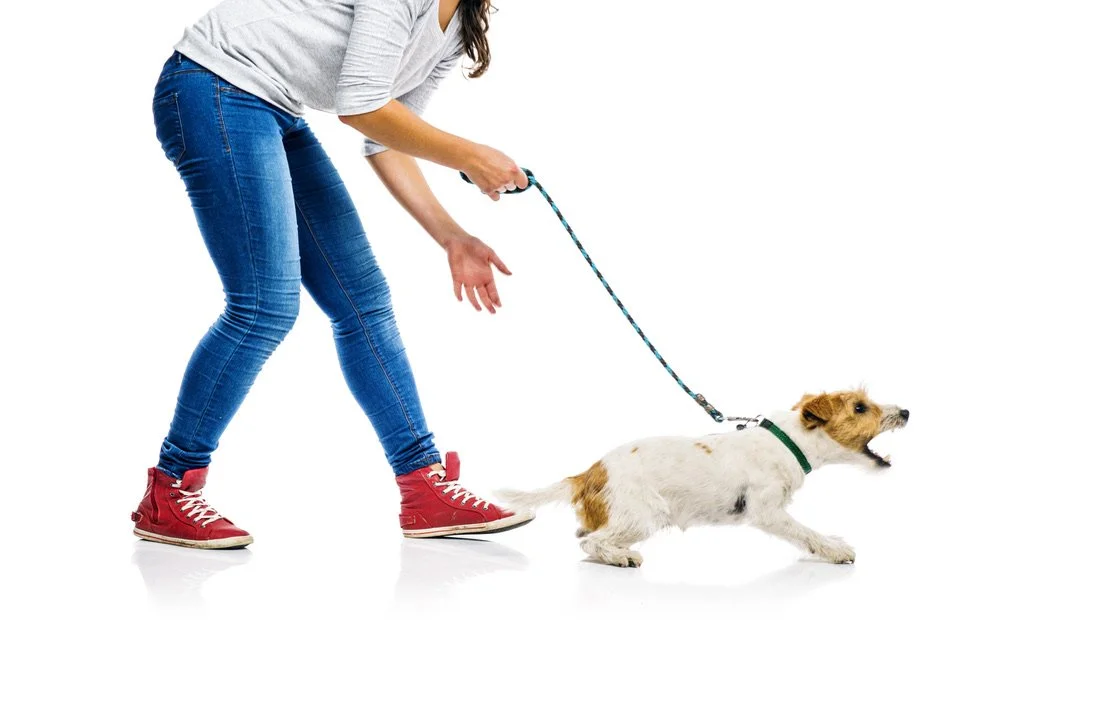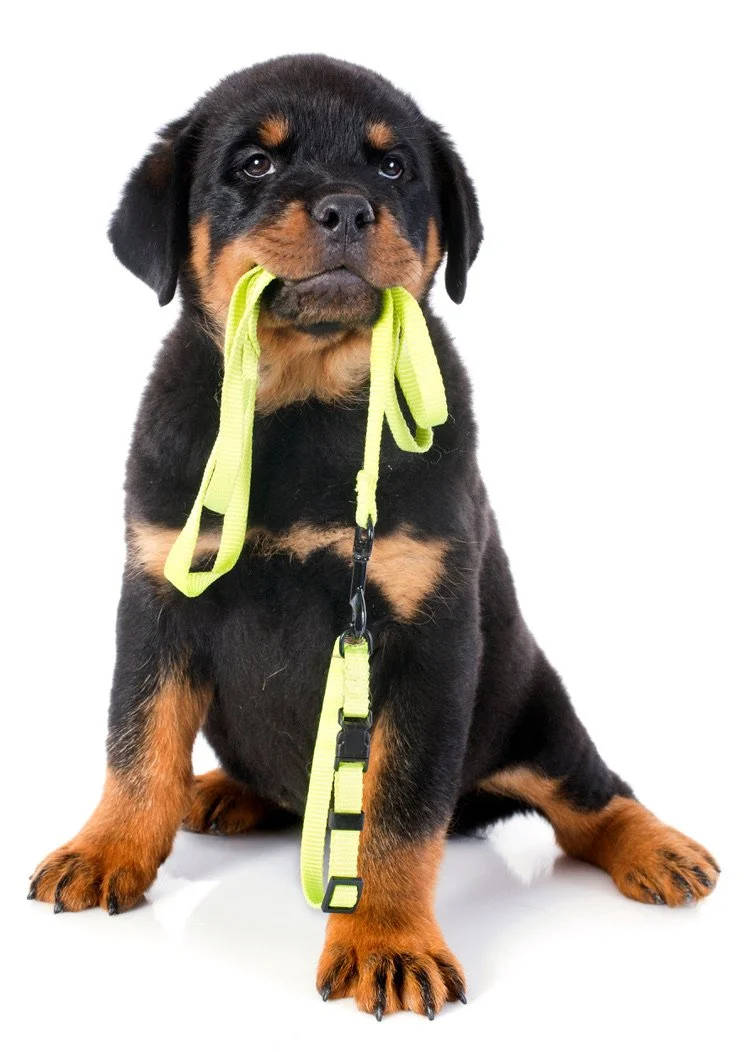Leash-Walking Trainer Secrets!
This article contains an excerpt from the Do No Harm Dog Training and Behavior Handbook Chapter, “Leash-walking” in PART 3 “Good Manners and Basic Training”, p 187.
Leash-walking
Trainer Secrets
By Linda Michaels, M.A., Psychology
Safety, comfort, and stress reduction are the most important criteria when selecting equipment used for training leash-walking skills. The use of equipment causing stress or pain, such as choke, prong, or electronic shock collars, is antithetical to Do No Harm training and is harmful to dogs. These devices are at odds with the positive relationships pet parents are developing with their dogs. Studies show these devices cause, rather than cure aggression, and otherwise worsen behavior. Additionally, medical research shows that pressure on the neck may cause injuries that include cervical spine injury, burst capillaries in the eyeballs, foreleg nerve damage, and damage that affects the function of the esophagus and trachea, causing breathing impairment (Overall et al., 2006). A standard flat collar is acceptable to hold identification tags but not as the attachment point for the leash.
Wear your treat bag or carry a pocketful of high value treats such as cheese bits or hot dogs while teaching leash-walking so your dog develops a habit of focusing and connecting with you while on leash.
Most right-handed pet parents walk their dogs on their left side, leaving their right hand free to open doors, greet others, or carry a package. Professionals typically walk dogs on their left side. However, choose whichever side you are most comfortable with and be consistent. Ideally, choose the side to walk your dog that everyone in your family agrees upon
Leash-Walking Equipment
The easiest way of achieving successful leash-walking begins by starting down the right path with the right equipment early in your dog’s life: however, loose-leash walking may be learned at any age. The following equipment is recommended:
Harness
A front, back, or double-clip harness is recommended for all dogs and puppies, including dogs who have developed a habit of pulling on the leash during the walk. An X, Y, or H style harness provides the best mobility, prevents chafing, and allows free movement of the limbs and proper gait. Some trainers prefer the back clip on these styles because of possible mobility and gait issues. Small dogs that do not pull may prefer a step-in harness. Most veterinarians strongly recommend a harness rather than a collar for all brachycephalic breeds with a short muzzle. These dogs are already susceptible to upper respiratory breathing issues, so they breathe easier without the added pressure of a collar around the neck, as do all dogs.
Leash
A four or six-foot leash is recommended for leash-walking contingent upon your dog’s skill and the situation. The longer leash provides your dog the freedom to make choices and is often preferred for training loose-leash walking. The shorter leash is recommended for dogs who bark and lunge on leash for safer control, if necessary, to prevent hazards. A “long line” is preferable for walks where your dog does not need to be close to you for safety reasons, and are wonderful for practicing “Lighting Recall” (See the Do No Harm Handbook, p 184)
Leash-Walking Skills
Basic Principles
To improve loose-leash walking skills, practice training off-leash indoors first, teaching your dog to walk close to you. Below find two of the basic principles for successful loose leash-walking:
1. No pulling, no thank you. Do not go where your dog pulls you! Instead, when your dog pulls, stop walking. Change direction the instant you feel pressure from your dog on the leash: stop, plant your feet, and pivot, making a 180-degree turn in place and begin walking again, while saying “Let’s Go” (see below). Click/treat when your dog is at the correct location after catching up to you. If you allow your dog to pull you, you are inadvertently reinforcing pulling during walks and your dog responds by pulling harder. Your consistency in not following your pulling dog is very important.
2. Maintain a connection between yourself and your dog while out on walks. Dogs often become environmentally fixated when there is so much to see, hear, and smell. Actively maintain your bond with your dog while out on walks. You are taking a walk together.
“Let’s Go”
Walk from the stationary position. Use the words “Let’s Go” signaling your dog that something different is going to happen on the walk. “Let’s Go” means, “I am leaving, and you are coming with me!” Practice “Let’s Go” whenever you move from a stopped position while on walks. “Let’s Go” is the green light. It also has the effect of a turn signal before making a change in direction. If you use this phrase often, your dog learns what it means, while sniffing when it is time to move on, when you are planning to cross the street, or when leaving another dog and continuing your journey. It is so exciting when you and your dog work as a team!
Name Response on Leash
Use Name Response (See Basic Skills, p 184 in the Do No Harm Handbook) when you want to get your dog’s attention immediately for any reason while leash-walking. Call your dog’s name while on leash. Teach your dog to look at you for further instruction, as a check-in behavior while on walks, and to redirect fixation on other dogs, distractions, or stressors.
1. Call your dog’s name.
2. The instant your dog makes eye contact with you, mark it with a click/treat, a “Good”/treat, or simply a treat.
Automatic Eye Contact
Reward your dog generously in some way for both looking at you automatically without being asked and for looking at you when you use Name Response. Start marking and rewarding whenever your dog freely offers eye contact while walking on leash without calling your dog’s name. You can click/treat or just treat. Turning toward you when called and making eye contact without being asked are highly desirable behaviors your dog can do while leash-walking and keeping a connection with you. The goal is having your dog check in with you frequently.
Slow Walking
You want your dog to learn that walking slowly and calmly with you is rewarding. Walking at the slow pace of a human generally must be taught to dogs. It is not natural for a healthy, young dog to walk slowly: if it were up to your dog, your dog would be zigzagging and circling everywhere you go. The slower the better to start. Do not let your dog rush you. You should decide speed, direction, “sniff-sniff ” breaks, and when and where to stop, although going on walks letting your dog choose the route is one type of valuable enrichment of choice and can be fun for you too. Try it!
Hand Targeting Heel
Many interesting, complex, agility, and service dog behaviors begin using a target. The purpose of hand-targeting for leash-walking is a technique of using your hand as a target for your dog to follow. That is, teach your dog to follow and touch your open hand with the nose while you are both in the leash-walking position. The presentation of your hand is both the hand signal and the target to be touched.
1. Begin by practicing off-leash at home with no distractions.
2. Stand in standard leash-walking position with your dog at your side and your dog’s head near your leg or knee or a slight bit behind you.
3. Hold your left hand down at your side if you are right-handed.
4. Teach your dog to touch your palm with the nose. The first step may be simply a glance at your hand. You may wiggle your hand until your dog touches the palm of your hand with the nose. Or rub your hand with a little bit of food to lure your dog to touch the palm of your hand. Click/treat or “Good”/treat any movement toward your hand.
5. Add the word “Touch” as your dog touches the palm of your hand with the nose.
6. Take one step forward, say “Touch,” and mark the touch the instant your dog touches the palm of your hand with the nose. Reward.
Hand targeting is useful for teaching many other behaviors. Present your hand with your palm facing outward. Then add distance, change direction, change hand and add distractions. Other practical uses for hand targeting in addition to leash training include
• Speeding up or slowing down while leash-walking
• Coming to your hand
• Standing in back of you
• Getting on or off the couch
• Ringing the bells as a request to go outside: place your open, target hand behind the bells
See “Walks — Working Below Threshold”, in the Do No Harm Dog Training and Behavior Handbook. Get your copy today!



